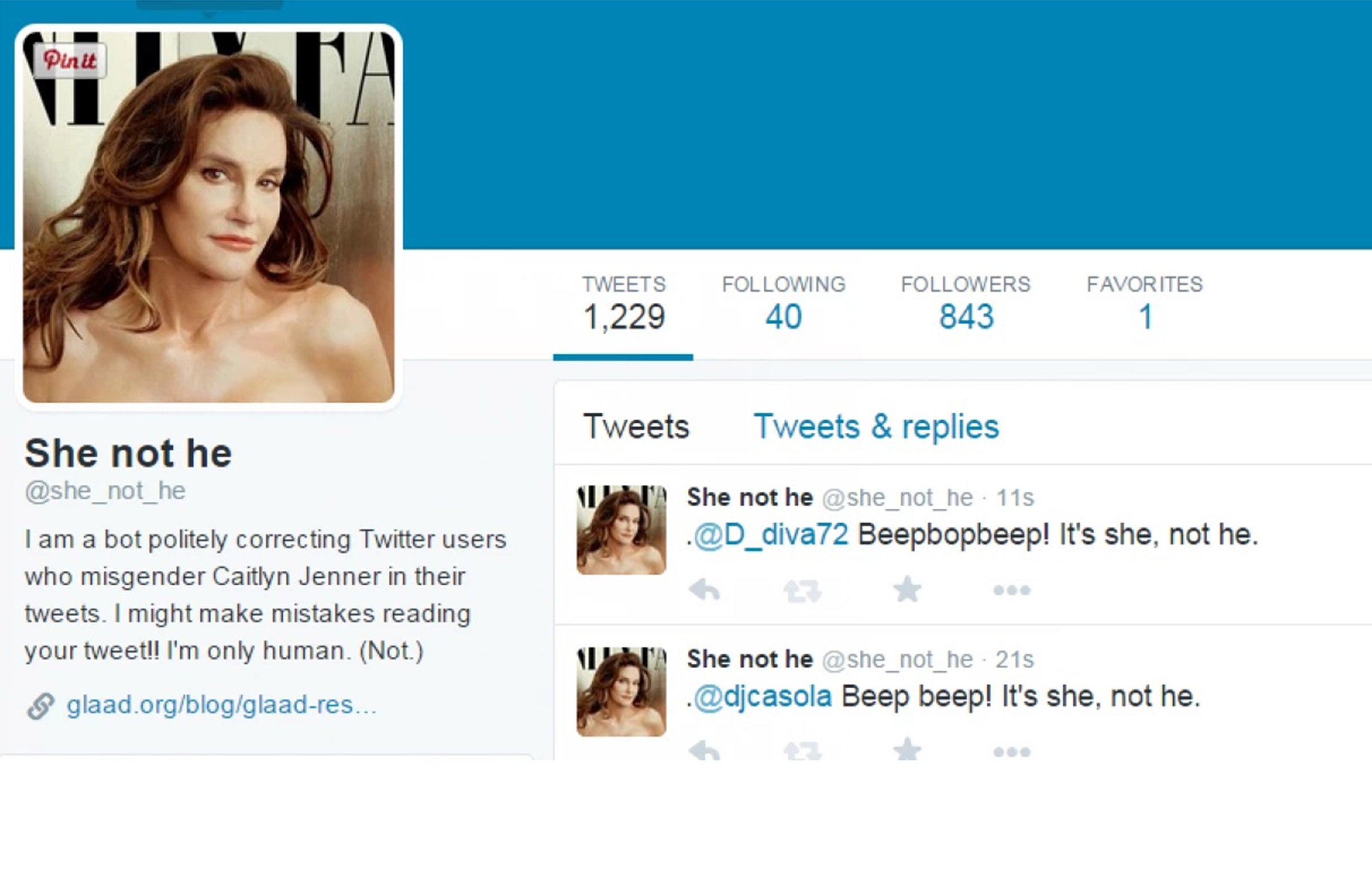Here's what I learned after creating Caitlyn Jenner Twitter bot @she_not_he
An effort to combat 'misgendering', as the practice is known in the LGBT community, yielded some interesting results

In the minutes after Caitlyn Jenner’s Vanity Fair cover went public, the Associated Press made a big whoopsie: They tweeted — and then deleted — a message in which they referred to Jenner as a “he.”
“Misgendering,” as this practice is known is the LGBT community, isn’t just a style error in violation of AP’s own rules — it’s a stubborn, long-time hurdle to transgender acceptance and equality, a fundamental refusal to afford those people even basic grammatical dignity. In fact, almost any time a transgender person is in the news, online errors like this run rampant. And because I cover the Internet, which is nothing if not a merry-go-round of cyclical hysteria, I knew that with Jenner, it would happen again.
So, a friend and I cobbled together a rudimentary Twitter bot to quietly, politely correct misgendering errors like the AP’s. You might’ve heard of it! It tweets under the handle @she_not_he.
The bot was designed by moi and coded, in its second iteration, by the brilliant Andrew McGill (… which is why it improved markedly around 6 p.m.) It essentially searches for mentions of “Jenner” and “he,” screens out a series of terms that turn up false positives, and then sends the offending tweeter a polite, robotic correction.
Since a string of online outlets discovered the bot last night, it’s gained pretty steady steam: 1,300 Twitter mentions and 800 followers, as of this writing. We suspect the Interest will fade down as the news cycle moves on. But for a span of hours, sitting behind the controls of @she_not_he, I got a very unusual, up-close look at the conversation around Jenner’s transition — and the way social media impacts these narratives more generally.
The world’s most followed Twitter accounts in 2014
Show all 10See, there are four distinct types of people who respond to an automated, misgender-correcting bot. You have your bot-haters, who are perhaps justified in their hate. (“This is spam,” “You can’t read,” etc.) You have your irredeemable, stomach-turning transphobic folks, who are rarely justified in anything. (“Shut up, he’s an it now anyway.”) You have your fans, your improbable followers, all tweeting praise-hands and #followfridays.
Best of all, though, are the reformees. There are very, very few of them, admittedly — but particularly in the beginning, before the bot went viral, we saw strings of well-meaning @-replies from tweeters around the country, tweets that apologized for ignorance or explained that they hadn’t previously known about these things.
This is extraordinary, when you think about it; or at least it seems so to me. Our online dialogues have become so toxic, so militarized, that it’s rare to change a mind or meet in the middle or otherwise agree reasonably on just about anything. Complaints about “ethics in journalism” flare into destructive doxing campaigns. SWAT teams descend on teenage kids who thought they were playing a friendly video game. Academic disagreements become Twitter wars. And the comments section of literally every Washington Post politics story — seriously, go look — devolves into ungrammatical, ad-hominem attacks, a grim pageant of “you’re dumb” and “look in the mirror” and other uncalled-fors.
Is it possible to “politely correct” misgendering, in this environment? Is it possible to talk politely about anything? The overwhelming bulk of the @-replies to @she_not_he bear out my skepticism on this issue, as does the prevailing research. According to a recent survey from Pew, more than one in four Facebook users has defriended a relative or acquaintance over their political beliefs.
And yet, there were those few precious apologizers, the ones who said sorry, that they’d “get it right” next time. In some ways, their heartfelt responses to a dumb Twitter bot aren’t just surprising or gratifying. They’re kind of, sort of, revolutionary.
I don’t want to overstate the importance of what was basically a Twitter stunt, of course. @She_not_he will shortly fade from Internet memory, soon to be overtaken by another misgendering scandal, another Twitter bot.
But there’s the seed of a suggestion here … that maybe compromise and dialog are possible on the Internet. After all, as one transgender woman tweeted to @she_not_he, life — online and off — it “is about treating others with respect.”
Coopyright: Washington Post
Subscribe to Independent Premium to bookmark this article
Want to bookmark your favourite articles and stories to read or reference later? Start your Independent Premium subscription today.

Join our commenting forum
Join thought-provoking conversations, follow other Independent readers and see their replies